How to Carry Over Your Brand’s Voice Into Packaging
By: phase1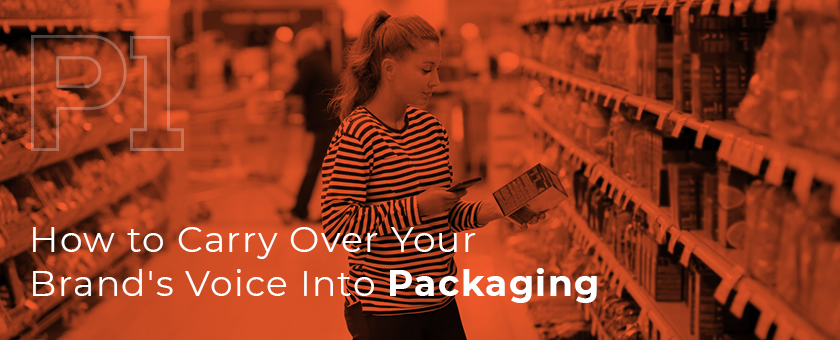 Packaging offers an opportunity to turn your brand into an experience. Creative or colorful packaging attracts attention on store shelves and can be a big reason a customer chooses your product over another one. With smart design, opening a package can be an adventure for the senses. Excellent packaging that communicates your brand voice creates a positive association with using your product and may increase future sales.
Packaging offers an opportunity to turn your brand into an experience. Creative or colorful packaging attracts attention on store shelves and can be a big reason a customer chooses your product over another one. With smart design, opening a package can be an adventure for the senses. Excellent packaging that communicates your brand voice creates a positive association with using your product and may increase future sales.
What Is Brand Voice?
Your brand voice refers to the distinct vocabulary you use to communicate with your customers, employees and investors. That language is verbal, visual and emotional. Your brand is the personality of your business, and developing a brand voice involves creating a complete image of who you are in words, attitudes and values. Many companies flesh out their brand identity by imagining their company as a person. What would that person sound like? How would they dress, and who would they hang out with?
A company’s brand voice distinguishes them from their competitors, especially within the food industry. When two competing products have similar recipes — whether they’re chocolates, crackers or sodas — branding sets them apart. It’s one of the reasons why “Coke or Pepsi?” is such a universal ice breaker question. Both brands have a distinct identity and brand voice, which consumers align themselves with.
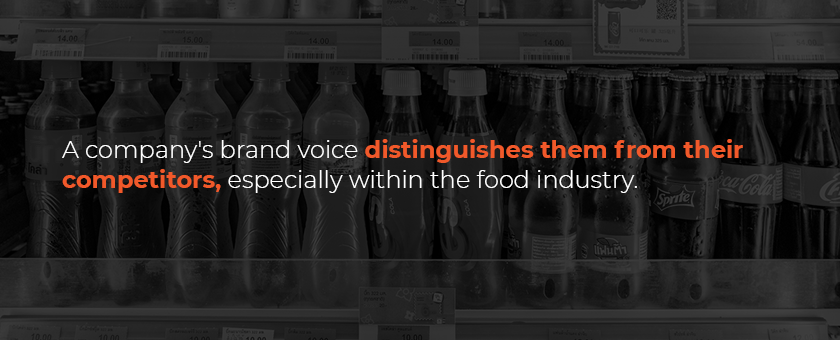
Your brand voice allows you to connect to your target audience through your social media, website and package design. It creates an emotional connection, and it makes your company seem relatable and approachable.
Why Brand Voice Should Be Incorporated Into Packaging
Packaging takes the digital experience of a brand and turns it into something tangible — customers can touch it and feel the material between their fingers. A brand voice works best when it is uniform. If your audience sees a fun and quirky tone on Instagram and an “all-work-no-play” attitude on your website, you send two different messages. Some people might even think the pages belong to two different companies.
You can increase revenue by up to 23% with a consistent brand presentation across all channels — including packaging. When customers interact with your brand online, they should remember your product later. If you carry your brand identity over to your product branding, it’s instantly recognizable on store shelves. The color and font stand out as something familiar.
In other cases, your product packaging might be a customer’s first interaction with your brand. If someone hasn’t met you in the digital world, your package is the first chance to introduce yourself. You want the visuals and product description on the label to show your customer what you stand for.
The packaging experience is just as important for online shopping. When a product arrives in packaging that looks like your brand does online, it showcases your dependability. Packaging is also critical to relationship building. It influences how the customer feels using the product. Is the package easy to open and reseal? Does the material feel high quality? Does the label give clear instructions? All these factors can make or break the experience of using the product.
How to Create a Brand Voice If You Don’t Have One
As a company bringing a new product to market, you might be considering brand voice for the first time. To create a brand voice that encapsulates who you are and what you stand for, consider what you want to be known for and what will connect with your customers. We divided this process into five steps.
1. Focus on Three Words
The key to a robust and evocative brand voice is consistency. Every social media post, product description and customer interaction needs to communicate the same message and feelings. With too many focal points, your brand can become jumbled and disconnected. With too few, the brand can become stale. Choose three descriptive and emotive words to have a nice balance.
An excellent way to decide on your brand voice words is to ask yourself, “What do I want customers to feel when using my products?” You might want them to feel energized, relaxed, safe, satisfied or inspired. Another angle is to consider what you want customers to think of your brand. In this case, you could choose words such as reliable, honest, caring, sharp or bold. These descriptive words will direct the tone you use in your social media, advertising and packaging.
2. Develop Your Brand Values
With three defining words selected, expand on each one to create values. These are the ideas you stand for. If you picked “honest” as one of your brand words, consider how you incorporate honesty into your brand. For a granola bar product, this value might encompass something like, “We only use ingredients you can pronounce.” For a skincare brand, this principle could be “Attainable results and realistic beauty standards.”
These brand values communicate your company’s mission and highlight what you want to avoid. For the skincare brand, the mission drives them to create products with visible results. At the same time, they might work with models who look relatable and down-to-earth. Whatever your company’s values are, they should permeate every level of your brand.
3. Research Your Target Audience
While your brand says who you are and sets you apart, it should also appeal to your target audience. Your personality should feel relevant to the customers you want to attract. To consider your target audience’s values, pull market research into the conversation, or do some investigative work.
A fantastic strategy is to look at your social media followers. Most social platforms give you rich insights into your followers, including:
- Where they live
- How old they are
- What gender they are
By understanding which posts attract the most engagement, you can learn what elements of your personality are resonating with your audience. Use this information to pivot your brand voice towards these demographics.
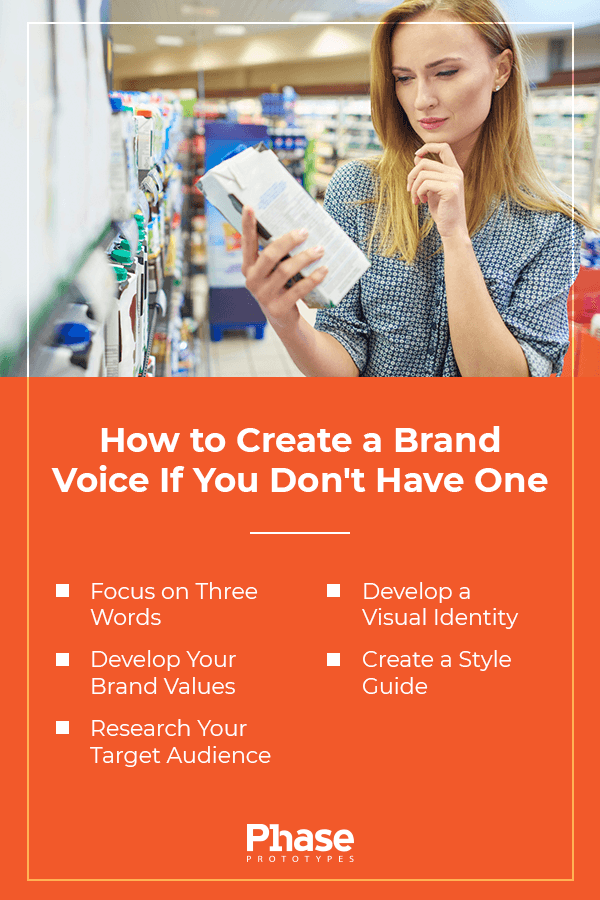
4. Develop a Visual Identity
Your three focus words and brand values can also translate into visual elements. Brand visuals are more than just a logo — although a logo is a direct symbol for who you are. Your visual identity encompasses how you use the following elements:
- Colors
- Patterns
- Fonts
- Imagery
A brand that uses “bold” as one of their identifiers might gravitate towards bright, loud colors like orange or lime green. They also might use a bold typeface. A company that wants users to feel relaxed might use wavy blue lines to evoke the calming ocean.
5. Create a Style Guide
Once you decide on a brand identity, you have to ensure it remains consistent. Establishing a style guide for how your marketing and design team present the company ensures everything you put forth conveys the same messaging. You can do this with your brand tone of voice guidelines.
There are many ways to organize a brand style guide. The idea is to implement a set of standards so the brand does not become diluted with off-brand messaging and visuals. Important elements to consider include:
- Focus words: Your style guide should include the three keywords that encapsulate your brand.
- Brand language: The style guide is also a place to expand on the language that surrounds your brand — especially if there are words your brand doesn’t use or particular phrasings you prefer.
- Visual guidelines: You should define the visual language of your brand in the style guide. For example, you might have a decorative font that can only be used in headings but never in body text.
- Color and logo guidelines: You might have a rule about which colors to show your logo in and how big it can appear on specific platforms.
- Examples: Whatever guidelines you settle on, include examples of correct and incorrect usage.
How to Carry That Brand Voice Into Your Packaging
While most elements of your brand exist in two-dimensional and digital forms, packaging is different. Many designers argue for a creative approach to package design. The goal is to translate a style guide into a physical and branded container. With package design, you have to consider more than appearance — you must also incorporate materials, texture and shape.
1. Font
In package design, you use lettering to display the name of the product and its description. You might also include a slogan, directions and a list of ingredients. Many brands use more than one font in their packaging, with one font for titles and another for body text. Some may even use three. Generally, any more than three typefaces in a single design can look disorganized
There are several types of fonts you can choose from to project the appropriate image:
- Serif fonts: A serif typeface has details known as flags or tags on each letter. Times New Roman and Georgia are two well-known examples. As the oldest category of font, serif is conventional, dependable and respectable.
- Sans serif fonts: Sans serif typefaces are easy to read and do not have serifs. Sans serif fonts such as Helvetica and Calibri are neutral and contemporary. This category is clean, simple and modern.
- Modern fonts: A modern typeface has thin serifs and high contrast between thick and thin strokes. Bodoni is an often-used example. Modern fonts catch the eye and express elegance, intelligence and determination.
- Script fonts: Script typefaces have a handwritten appearance, often replicating cursive or calligraphy. Lobster is an example of a popular script font. These fonts look emotional, creative and feminine.
- Display fonts: A display font is usually custom-designed for a particular company. Disney and Lego both use a display font in their logos. Because these fonts are creative, they can mean anything. They might project fun, quirkiness or a casual tone.
2. Colors
Many brands have at least one signature color, such as Coca Cola red or Cadbury purple. You can improve brand recognition by up to 80% with color alone. Color can express many different things to consumers, and each color carries a psychological implication. Water brands such as LaCroix use colorful packaging to pitch water to consumers as a soda alternative.
3. Packaging Shape
Packages are physical objects that your customers will touch and interact with. Bringing your brand voice into packaging means designing in three dimensions. Even if you select a conventional shape for your packaging, you must consider how it looks from many angles.
In 2018, Diet Coke proved you can alter brand perception with a change in package shape. The brand redesigned its short cans into tall, skinny ones. The company feels the new design has a more contemporary, gender-neutral look. Creative packaging shapes can also help a brand differentiate themselves in the market. Many tea companies sell tea bags in unique shapes, such as fish and butterflies. A heart-shaped box is a must for candy companies hoping to increase holiday sales for Valentine’s Day.
4. Packaging Feel
Thin and flimsy packaging can make a product feel low quality. In addition, it may not provide enough protection, which can leave a negative impression in the consumer’s mind. Thicker material can represent luxury and even make a product appear higher quality. Glossy or matte varnish ink can highlight your logo and add texture to your packaging. Embossed text also feels more tangible and high quality.
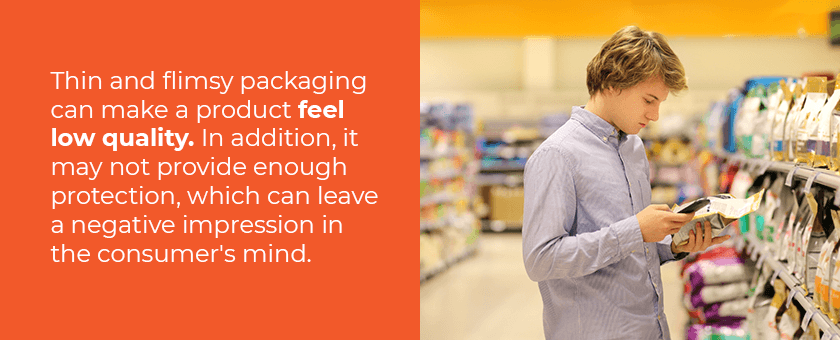
5. Packaging Materials
There’s a massive variety of materials available to package designers. Cardboard, plastic and metal are three popular options. Consider packaging lip balm in a metal tin versus a plastic tube. An aluminum container looks and feels distinct, but a tube is more convenient. Choosing one packaging material over another affects how consumers see your brand.
Transparent packaging is a trend that’s seen more traction in the last few years. It reveals the product, allowing a consumer to make a decision based on what the product looks like. It also portrays honesty and shows the company has confidence in what it produces.
Other brands use sustainable packaging to communicate their care for the environment. A food brand that uses natural ingredients might choose compostable packaging to reflect this aim.
Brands That Expertly Carry Over Brand Voice to Packaging
Brands that have mastered package design consider more than the look and feel of their packaging. They also plan how to place the products inside their boxes. These brands carefully craft a sensory experience meant to delight their customers as they open the package. Two strong examples are tech giant Apple and beauty brand Glossier.
Apple
Known for its minimalist products, Apple carries its design philosophy into its packaging. Apple products come in white boxes that are printed with a metallic font. The boxes often have a picture of the product shown in profile, like a closed MacBook or the edge of an iPhone. This imagery presents an uncluttered and simple design.
Apple has a package designer on staff dedicated to opening prototype boxes. They test hundreds of box shapes, angles and tapes to find a combination that’s easy to open. The company also focuses on packing boxes in an aesthetically pleasing way that makes it easy to find the components and begin using a product.
Glossier
The beauty brand Glossier has a distinct brand value: democratize beauty. The brand’s products reflect this principle with a simplistic black and white design, an italic sans serif font and as little text as possible.
As an e-commerce company, Glossier puts careful consideration into the design of their shipping boxes. The outside of the box is minimalist — a brown cardboard box, sealed with a branded black and white strip of tape. They design the unboxing process to be exciting and social media-worthy. The interior of the box is coated in pastel pink, and each product is safely housed in a reusable pink cushioned bag.
Experiment With Brand Voice in Your Prototype Packaging
Your brand voice is your company’s philosophy, personality and unique flair. Developing a strong brand voice is critical to driving your marketing efforts, and your packaging is the vehicle to deliver your brand voice to customers. Many brands go through several packaging iterations before they land on the designs that transform their voice into a three-dimensional structure.
As you develop and refine your voice and package design, it’s helpful to have options to choose from and prototypes to experiment with. That’s why Phase 1 Prototypes offers a variety of package printing solutions and mock-up services to help you bring your product to market. We welcome unique packaging challenges and creative designs. Reach out to us with any of your packaging questions today.
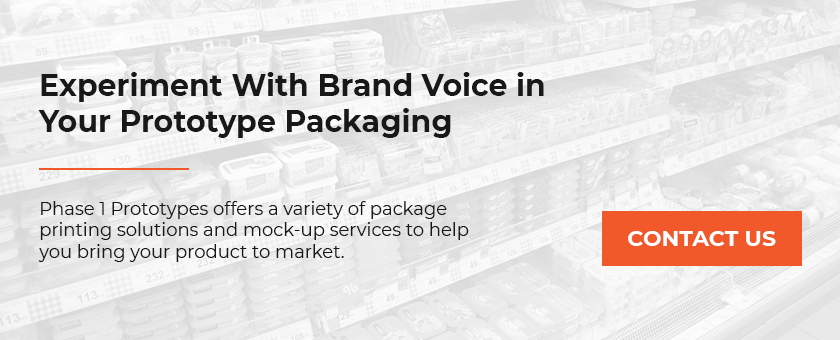

Leave a Reply